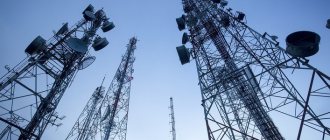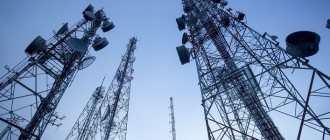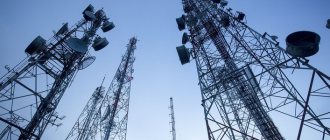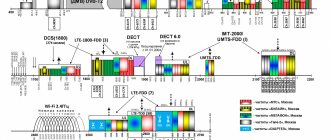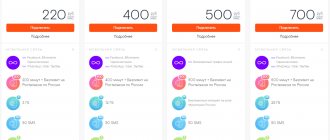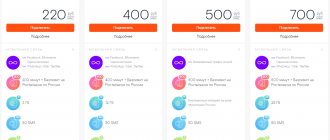Today, Russian mobile operators are actively expanding the coverage area of fourth generation networks. LTE is a term used to refer to networks with a throughput of at least 10 Mbps. 4G networks are a new communication standard, which is characterized, first of all, by fast connections and high quality voice calls.
List of LTE frequencies used by Russian mobile operators
The 4G networks of each domestic operator are located in a certain frequency range. The presented table contains information about LTE bands (from the English Band), which are supported in our country:
| Band name | Frequency |
| Band 3 | 1800-1880 MHz |
| Band 7 | 2620-2690 MHz |
| Band 20 | 790-820 MHz |
| Band 31 | 450 MHz |
| Band 38 | 2570-2620 MHz |
The LTE standard is not compatible with second and third generation networks, so special data transmission channels were allocated for it. Band is the frequency bands of any LTE network. The band number indicates the period when the given range began to be used in the world (there are currently 44 bands).
The bands presented in the table are used by each cellular operator. It should be noted that these frequency ranges are constantly expanding, which allows providers to provide Internet connections to a larger number of users.
In some cases, operators unite to build cell towers: a similar agreement was concluded in 2021 by Beeline and Megafon. Another example of cooperation was the agreement between Beeline and MTS, according to which the operators use common frequencies in the territory of some constituent entities of the Russian Federation.
The acquisition of bend frequencies occurs through open bidding, in which providers buy the right to broadcast their signal on certain channels. MTS, for example, spent 4 billion rubles on the 2500 MHz band, distributed throughout the Russian Federation except the Moscow region and Crimea. Tele2 was the first to launch 4G in the Kaliningrad region and a number of other regions of our country at a frequency of 450 MHz.
Why are there so many frequencies?
Examining the results of 2010, the GSM Association stated: 80% of the planet's subscribers are covered by the standard. This means that four-fifths of networks cannot choose a single frequency. In addition, there are 20% foreign communication standards. Where does the root of evil come from? The countries of the second half of the twentieth century developed separately. The frequencies of 900 MHz of the USSR were occupied by military and civil air navigation.
Frequency 900 MHz
GSM: 900 MHz
In parallel with Europe’s development of the first versions of GSM, NPO Astra, Radio Research Institute, and Research Institute of the Ministry of Defense began research that ended in full-scale tests. The verdict:
- Navigation and second generation cellular communications can function together.
On July 25, 1992, it was decided to create two systems:
- GSM.
- NMT-450.
Please note: again 2 standards. Each uses its own frequency grid. The announced competition for the distribution of GSM-900 was won by NPO Astra, OJSC MGTS (now MTS), Russian companies, and the Canadian BCETI.
NMT-450MHz - first generation
So, Moscow used, starting in 1992, the 900 MHz band (see above), because other GSM frequencies had not yet been born. In addition, NMT (Nordic Mobile Phones)… Initially, the countries of the Scandinavian Peninsula developed two options:
- NMT-450.
- NMT-900 (1986).
The reason for the Russian government choosing the first answer? They probably decided to try two ranges. Please note that these standards describe analog communications (1G). Developing countries began closing up shop in December 2000. Iceland (Siminn) was the last to surrender (September 1, 2010). Experts note an important advantage of the 450 MHz range: range. A significant plus, appreciated by remote Iceland. The Russian government wanted to cover the country's area using a minimum of towers.
NMT is loved by fishermen. The freed network was occupied by digital CDMA 450. In 2015, Scandinavian technologies mastered 4G. The Russian Uralwestcom vacated the closet on September 1, 2006, Sibirtelecom - on January 10, 2008. The subsidiary (Tele 2) Skylink fills the Perm and Arkhangelsk regions with its range. The license expires in 2021.
D-AMPS: UHF (400..890 MHz) - second generation
American 1G networks that used the AMPS specification refused to accept GSM. Instead, two alternatives have been developed to organize second generation mobile networks:
- IS-54 (March 1990, 824-849; 869-894 MHz).
- IS-136. Features a large number of channels.
GSM/GPRS standard
The standard is now dead, replaced everywhere by the descendants of GSM/GPRS, CDMA2000.
Why does a Russian need D-AMPS?
The Russian average person often uses used equipment. D-AMPS equipment has reached the warehouses of Tele 2 and Beeline. On November 17, 2007, the latter closed up shop for the Central Region. The license of the Novosibirsk region expired on December 31, 2009. The last swallow flew away on October 1, 2012 (Kaliningrad region). Kyrgyzstan used the range until March 31, 2015.
CDMA2000 - 2G+
Some protocol variants use:
- Uzbekistan – 450 MHz.
- Ukraine – 450; 800 MHz.
In the period December 2002 – October 2021 specifications 1xRTT, EV-DO Rev. A (450 MHz) Skylink was used. Now the infrastructure has been modernized, LTE has been introduced. On September 13, 2021, the news spread across world portals: Tele 2 is stopping the use of CDMA. The American MTS began the process of introducing LTE a year earlier.
GPRS – second or third generation
The development of the CELLPAC protocol (1991-1993) was a turning point in the development of cellular communications. 22 US patents received. The descendants of the technology are considered LTE, UMTS. Packet data transfer is designed to speed up the process of information exchange. The project is designed to improve GSM networks (frequencies listed above). The service user is obliged to receive technologies:
- SMS.
- MMS.
- Access to the Internet.
- Legacy "tap to talk"
- Messenger.
- P2P.
- P2M.
The overlay of two technologies (SMS, GPRS) speeds up the process many times over. The specification supports IP, PPP, X.25 protocols. Packets continue to arrive even during a conversation.
EDGE
The next stage in the evolution of GSM is conceived by AT&T (USA). Compact-EDGE has filled the niche of D-AMPS. Frequencies are listed above.
UMTS – full 3G
The first generation that required updating base station equipment. The frequency grid has changed. The maximum transmission speed for a line that takes advantage of HSPA+ is 42 Mbps. Actually achievable speeds significantly exceed 9.6 kbit/s GSM. Since 2006, countries have started renewal. Using orthogonal frequency multiplexing, the 3GPP committee intended to achieve 4G. Early Birds released in 2002. Initially, the developer laid down the following frequencies:
- .2025 MHz. Ascending communication branch.
- .2200 MHz. Descending connected branch.
Since the USA was already using 1900 MHz, it chose segments 1710..1755; 2110..2155 MHz. Many countries followed America's example. The 2100 MHz frequency is too often busy. Hence the numbers given at the beginning:
- 850/1900 MHz. Moreover, 2 channels are selected using one range. Either 850 or 1900.
Agree, it is incorrect to drag in GSM, following a bad common example. The second generation used a single half-duplex channel, UMTS used two at once (5 MHz wide).
UMTS frequency grid of Russia
The first attempt to distribute the spectra took place on February 3-March 3, 1992. The solution was adapted by the Geneva conference (1997). It was the S5.388 specification that fixed the ranges:
- 1885-2025 MHz.
- 2110-2200 MHz.
The decision required further clarification. The commission identified 32 ultra-channels, 11 of which constituted an unused reserve. Most of the others received clarifying names, since the individual frequencies coincided. Russia rejected the European practice, despising the USA, by adopting 2 channels (band) UMTS-FDD:
- No. 8. 900 MHz – E-GSM. The ascending branch is 880..915 MHz, the descending branch is 925..960 MHz.
- No. 3. 1800 MHz – DCS. The ascending branch is 1710..1785 MHz, the descending branch is 1805..1880 MHz.
The characteristics of the cell phone should be selected according to the information provided. The Wikipedia table revealing the frequency plan of planet Earth is completely useless. They forgot to take into account Russian specifics. Europe operates nearby IMT Channel No. 1. In addition, there is a UMTS-TDD mesh. The equipment of the two overhead network options is incompatible.
LTE – 3G+
Evolutionary continuation of the GSM-GPRS-UMTS connection. Can serve as an add-on for CDMA2000 networks. Only a multi-frequency phone can provide LTE technology. Experts directly indicate a place below the fourth generation. Contrary to the claims of marketers. Initially, the ITU-R organization recognized the technology as appropriate, but later the position was revised.
Wireless standard LTE
LTE is a registered trademark of ETSI. The key idea was the use of signal processors and the introduction of innovative methods of carrier modulation. IP addressing of subscribers was considered appropriate. The interface has lost backward compatibility, the frequency spectrum has changed again. The first network (2004) was launched by the Japanese company NTT DoCoMo. The exhibition version of the technology reached Moscow in the hot May of 2010.
Repeating the experience of UMTS, the developers introduced two options for the air protocol:
- LTE-TDD. Time division of channels. The technology is widely supported by China, South Korea, Finland, and Switzerland. Availability of a single frequency channel (1850..3800 MHz). Partially overlaps WiMAX, upgrade is possible.
- LTE-FDD. Frequency division of channels (separate downstream and upstream).
The frequency plans of the 2 technologies are different, 90% of the core design is the same. Samsung and Qualcomm produce phones that can support both protocols. Occupied ranges:
- North America. 700, 750, 800, 850, 1900, 1700/2100, 2300, 2500, 2600 MHz.
- South America. 2500 MHz.
- Europe. 700, 800, 900, 1800, 2600 MHz.
- Asia. 800, 1800, 2600 MHz.
- Australia, New Zealand. 1800, 2300 MHz.
4G LTE networks in Russia
Now you can familiarize yourself with the table, which presents the current characteristics of fourth generation networks in the Russian Federation.
| Operator | Frequency (upload/download), MHz | Duplex | Band |
| Yota | 2500-2530 / 2620-2650 | FDD | Band 7 |
| Megafon | 2530-2540 / 2650-2660 | FDD | Band 7 |
| Megafon | 2575-2595 | TDD | Band 38 |
| MTS | 2540-2550 / 2660-2670 | FDD | Band 7 |
| MTS | 2595-2615 | TDD | Band 38 |
| Beeline | 2550-2560 / 2670-2680 | FDD | Band 7 |
| Tele2 | 2560-2570 / 2680-2690 | FDD | Band 7 |
| MTS | 1710-1785 / 1805-1880 | FDD | Band 3 |
| Tele2 | 832-839.5 / 791-798.5 | FDD | Band 20 |
| MTS | 839.5-847 / 798.5-806 | FDD | Band 20 |
| Megafon | 847-854.5 / 806-813.5 | FDD | Band 20 |
| Beeline | 854.5-862 / 813.5-821 | FDD | Band 20 |
In addition to the five federal operators, there are also regional ones, each of which has its own frequency network.
Why do we need to know about frequencies?
You can cite many interesting scientific facts about why the average Russian should be interested in information about frequency parameters. For example, it is in the GSM standard that federal authorities listen to us and sell all kinds of bugs for listening. Why are there two numbers in the range designation? Absolutely all mobile gadgets are duplex devices. They work in two directions, and not like a walkie-talkie. That is, on the phone you speak and hear at the same time. If your gadget supports a certain list of frequencies, then it’s hard to argue with this, which is why locked iPhones smuggled into Russia refuse to work: the frequency is not the same.
Upper and lower frequencies
From a financial point of view, the development of LTE networks at lower frequencies (less than 2000 MHz) is most profitable for operators. Such frequencies penetrate buildings better, but are not able to provide high-speed connections to areas with high population density.
The functions of the upper frequencies are opposite to the functions of the lower ones, so the best option for a high-quality connection is a combination of both frequency channels, which allows you to get rid of “shadow” areas over large spaces.
Also in megacities, there is a tendency to install special devices on the roofs of office buildings to facilitate the spread of high-speed networks indoors.
What is the LTE Band 3 frequency range
Translated from English, the abbreviation “LTE” (Long-Term Evolution) means “long-term development”. This technology is a standard for high-speed uninterrupted and wireless data transmission, which is based on the other two technologies UMTS/HSPA and GSM/EDGE. During its implementation, by improving the qualities of the network core and using another radio interface with high bandwidth, it was possible to achieve good data transfer rates.
Schematic representation of the operation of 4G LTE mobile networks
Note! Mobile operators in different countries use different channels and radio frequencies for LTE. It follows that manufacturers of phones, PCs and network equipment were faced with the task of developing and producing multi-band gadgets.
According to the specifications of this technology, LTE networks provide incoming traffic speeds of up to 326 Mb/s, and outgoing traffic speeds of up to 173 Mb/s.
To use this technology, you must have a device compatible with it. In the vast majority of cases, devices are fully compatible with 4G LTE.
Basic LTE modes
The LTE standard is divided into two types: TDD and FDD.
The first implies temporal (from the English Time) division of the signal, and the second - frequency (from the English Frequency). FDD is a more convenient communication mode because, from the point of view of everyday use, it is more stable.
The difference between these concepts lies in the method of loading and unloading data. Thanks to FDD, parallel processing of incoming and outgoing Internet traffic occurs.
Imagine that a user is watching a video on YouTube and at the same time uploading an entire album of photos to the cloud storage. Watching a video will be considered a download operation, and sending a photo will be an upload, and in FDD mode the gadget distributes both operations over different frequency channels.
For example, LTE from the Russian Megafon operates at a frequency of 17 MHz, 11 of which can be used for downloading content, and the remaining 6 for uploading.
Separate traffic processing increases the stability of the speed of each individual process, thereby ensuring a better connection.
TDD processes traffic sequentially. In other words, over the same 17 MHz, both downloading and uploading of data will be carried out - but without separation, but alternately in one channel. The disadvantage of this mode is possible “jumps” in speed.
Currently, Russian cellular operators are striving to combine the operation of TDD and FDD stations. By combining modes into one network, providers increase the overall connection speed.
Range system
In each country, LTE operates on different frequencies. Currently, there are more than 44 frequency bands for 4G. To determine them, use the English value 4G band, which is marked with the symbol b with a digital prefix. One country may use one or more of these frequency ranges, divided into two categories:
- TDD;
- FDD
The first group provides sequential reception and transmission of the Internet signal. The second category FDD LTE is called the best option for high-speed Internet. This is explained by the possibility of simultaneous reception and delivery of an impulse. Such a system divides the FDD LTE channel into 2 separate parts.
LTE-advanced technology (4G+)
LTE-advanced is an “advanced” 4G network and is designated by Russian operators as 4G+. Although this name emphasizes the increase in speed of the new standard, it is not correct, since LTE-A in its actual performance is regular 4G. What is called 4G in Russia is significantly inferior to the nominal standards of fourth generation networks.
The advantage of the advanced standard is the summation of all frequencies owned by the cellular operator, which reduces the “sag” factor in the data transmission channel. By merging several band 7 bands into one, Megafon was able to increase the theoretical connection speed to 300 Mbit/s.
If we add band 3 frequencies to the frequencies of band 7, then the data transfer speed will be 450 Mbit/s (40 MHz + 20 MHz = 300 Mbit/s + 150 Mbit/s). Unfortunately, the actual throughput of advanced channels is lower than declared and corresponds only to nominal 4G standards.
Any cellular operator that has the appropriate license and the necessary equipment can use various frequency channels. Now there is a tendency to expand channel capacity, the volume of which depends on the frequency range. It is also worth noting that to support LTE-A, the user’s device must have special technical characteristics.
Which providers provide LTE services to subscribers?
Today, almost all domestic mobile operators use the 4th generation communication standard in their work and provide corresponding services to users.
Such providers include
- Yota. The first company to master and launch LTE in the Russian Federation. As of 2011, it had 63 base stations. Yota's 4G frequency occupies channel band 7.
- Megafon. Megafon began working with 4G in 2012. Today the coverage area covers almost the entire country. The company's equipment operates at frequencies b7, b38 and b20 (in the 7.5 MHz range, which does not quite correspond to the b20 standard).
- MTS. Provides LTE services in 83 regions of the country. Uses the 4G frequency FDD b7, as well as b20 and b38 (in all regions of the Russian Federation, except Moscow and the region, as well as the Autonomous Republic of Crimea and Sevastopol).
- Tele2. Successfully promotes new generation communication technology, uses the b3 band.
- Beeline. Official Beeline 4G frequencies b7 and b20.
This list is completed by Rostelecom, the Crimean operator Volna-Mobile, and the young provider Motiv.
Large companies use several bands.
MTS 4G frequencies occupy:
- b3 is LTE 1800;
- b7 or LTE 2600;
- b20 refers to LTE 800;
- b31 operates at latitude 450.
Megafon's LTE frequencies are allocated to a separate channel, which allows us to provide the best quality of communication to subscribers.
4G speed
It is worth understanding that the actual connection speed almost always differs from the nominal one. The theory does not take into account factors such as landscape, remoteness of cell sites, or the presence of the user in the building - such conditions interfere with the connection and significantly reduce its quality.
The speed of data transfer also depends on the operator’s workload: the more users have access to fourth-generation networks, the lower the speed indicators. The speed of the Internet connection in wireless networks is determined by the width of the frequency range, as well as the implementation of the communication duplex.
These specifications vary by operator. Although some providers guarantee 300 Mbit/s, the average actual speed is only 75 Mbit/s (Tele2, MTS and Beeline).
The already mentioned tandem of Beeline and Megafon recently began the transition to the LTE-advanced standard, which made it possible to increase speed to 160 Mbit/s in some coverage points.
Now such a standard is presented in Moscow and St. Petersburg, but the regions will have to wait a long time for it: the total distribution of 4G+ throughout Russia is now impossible for two reasons.
The first is the cost of the required equipment, and the second (follows from the previous one) is that as the coverage area increases, the load on existing cell towers will increase, that is, the average speed will only decrease.
Since the speed of the connection depends on the width of the frequency range, we can say that today Megafon is in the most advantageous position, which, after absorbing Yota, added channels of the acquired company to its own frequencies.
Theoretically, the Megafon network can operate on a 40 MHz channel and accelerate in FDD mode to 300 Mbit/s, but since part of the channel is given to subscribers of the subsidiary Iota, the actual speed is approximately 100 Mbit/s.
If we compare networks of the third and fourth generations, the latter have several times higher speeds: an average of 80 Mbit/s versus a maximum of 3 Mbit/s. HSPA+ was able to overclock 3G to 45 Mbps, but these figures still lag behind 4G.
How to find out the 3G, 4G frequency on your smartphone
To find out the frequency or range in which your mobile Internet operates:
- Disconnect from Wi-Fi and turn on mobile data (Cellular).
- An icon at the top of the screen next to your carrier's name will indicate whether you're connected to 3G, LTE, or 4G.
- Open dialer and enter the code. For Android - *#0011#, *#*#4636#*#* or *#*#197328640#*#*, depending on the version. For iPhone - *3001#12345#*.
- The menu that opens varies greatly among different smartphone models. You need to find in the menu Freq Band or Frequency (if you are connected to 4G) or WCDMA (if you are on a 3G connection). This field will indicate which frequency you are connected to.
In this menu you can see the status of the wireless network
Having understood the pros and cons of different frequencies, you can choose the operator whose coverage will suit you best. This way you can improve the quality and speed of your mobile Internet.
Further development of LTE
Despite the launch of testing of fifth generation networks in the world, some regions of the Russian Federation still do not even support 3G. In connection with this circumstance, it is worth predicting, first of all, the widespread development of LTE technology. Also, fourth-generation networks represent a non-alternative way of accessing the Global Wide Web in a number of Russian regions, which encourages domestic cellular operators to develop the 4G standard.
In some cases, a wired connection is simply impossible, which contributes to the spread of wireless technologies: the capabilities of cellular stations can be expanded thanks to special signal repeater antennas. The user can independently purchase such an antenna. It is important to consider that each repeater only works with certain frequencies and mode (FDD or TDD).
Content
Many owners of mobile devices who use Internet services from various providers are aware of the existence of outdated and new technologies for transmitting data over a wireless network. Thanks to constant improvement, older technologies are being used less and less, giving way to LTE. This new communication standard provides users with high Internet connection speed and signal quality. Internet in the village is the best option, Moscow region.
For successful operation, a certain 4G frequency is used in the Russian Federation. Information about your operator's frequency band may be useful when choosing smartphones and mobile modems, some models of which may not operate in the entire LTE frequency range.
VoLTE - support for voice calls over LTE
LTE networks are entirely IP-based and therefore support only data transmission in their basic form. There are developments that allow operators to offer voice solutions to their subscribers.
These are IP solutions that will provide the same interoperability, flexibility and uninterrupted performance that today's 2G and 3G wireless technologies offer.
IMS, multimedia subsystems using the IP protocol, have such capabilities. IMS enables operators to provide voice services in LTE networks. This ensures continuity of service when a subscriber moves from one network to another.
Events will develop according to the following scenario - leading operators will first implement data services on the LTE network, continue to use 2G and 3G networks for voice transmission, and then eventually move on to voice over LTE - VoLTE (Voice-over-LTE) based on IMS .
VoLTE is precisely a specification for the transmission of voice traffic from circuit switching systems and SMS to packet switching systems, i.e. directly over LTE networks using IMS.
Voice over LTE, or VoLTE, is similar to VoIP (Voice over Internet Protocol) - such as Skype, which uses the Internet to support voice calls over a broadband connection. Simply put, VoLTE allows voice to become another application that runs on the data network. This protocol can provide faster and better quality voice calls and even video chat tied to the service and your mobile phone number. Bonus for consumers: voice minutes are not paid.
Previous cellular networks, such as 2G and 3G, were designed primarily to carry voice calls. Later, these services added support for cellular data transmission by “tunneling” it within voice connections. LTE is a network technology designed for data transmission that uses Internet Protocol (IP) packets for all communications. Therefore, it does not support traditional voice calling technology, which means a new protocol and applications are needed to transmit voice over LTE.
The big advantage of VoLTE is that call quality is superior to 2G and 3G connections, as 4G can carry three times more data than 3G and six times more than 2G. It is essentially an HD voice call. It is much richer and uses the HD-Voice speech codec. But VoLTE only works if both the devices receiving and making the call support it.
VoLTE also requires both parties to the call to have 4G coverage. This means VoLTE calls won't always be available, and if someone moves out of 4G coverage during a call, there's a chance the call will be dropped.
Comments
Alexander 2020-03-13 17:52:00
Hello, a very useful article, everything is described in detail and clearly. This is a question, I am planning to organize 4G Internet from MTS in my house. The BS is 250 m away from me in direct visibility, on the Xiaomi mi 9T 4g+ phone it gives out. Through the e8732 modem I looked at the network parameters B7 (10 MHz) and B3 (10 MHz) from the same tower. As I understand it, if the smartphone provides 4G+ and judging by the modem readings? An operator with one BS in 2 bands is broadcasting, is this aggregation? Tell me what equipment do I need for maximum speed? Is it worth taking a cat 6 modem with an antenna in my conditions? Thank you in advance.
Hello, a category 6 modem (phone) can use 2 channels for data transmission. The speed of the mobile Internet will be the sum of the speeds of each of these networks separately. In the future, LTE networks will develop even more rapidly, so my answer to YOU is yes, it’s worth it.
Multiplexing Basics and Using MIMO in LTE
LTE uses MIMO systems to improve reliability and to increase data transfer rates. Typically, a MIMO system consists of m transmit antennas and n receive antennas.
In simple terms, the receiver receives a Tx signal, which is obtained when the Rx vector of the input signal is multiplied by the Q matrix of the transmission. Tx = Q * Rx. The transmit matrix Q contains channel impulse responses that refer to the channel between transmit antenna m and receive antenna n. Many MIMO algorithms are based on analyzing the characteristics of the transmission matrix Q. The rank (of the channel matrix) determines the number of linearly independent rows or columns. It specifies how many independent data streams (layers) can be transmitted simultaneously.
Improving data transmission reliability - transmission diversity
When the same data is transmitted redundantly over more than one transmit antenna, it is called transmit diversity. This increases the signal to noise ratio. Space-time codes are used to generate the redundant signal. Alamouti developed the first codes for two antennas. Today, different codes are available for more than two antennas.
Increasing Data Rate - Spatial Multiplexing
Spatial multiplexing increases data transfer rates. The data is divided into separate streams, which are then transmitted simultaneously over the same air interface resources. The transmission includes special sections (also called pilots or reference signals) that are also known to the receiver. The receiver can perform channel estimation for the signal from each transmitting antenna.
In the closed-loop method, the receiver reports the channel status to the transmitter through a special feedback channel. This allows you to quickly respond to changing channel conditions, for example, adapting the number of multiplexed streams. When the data rate must be increased for single-user equipment (UE), it is called single-user MIMO (SU-MIMO). When separate streams are assigned to different users, it is called multi-user MIMO (MU-MIMO).
What are MIMO and MU-MIMO, how does this technology work and what does it do for the end user?
